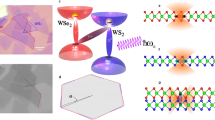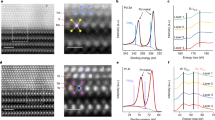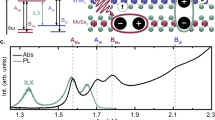Abstract
Photodiodes based on two-dimensional semiconductors are of potential use in the development of optoelectronic devices, but their photovoltaic efficiency is limited by strong Fermi level pinning at metal–semiconductor contacts. Typical metal–interlayer–semiconductor contacts can address this issue, but can also lead to an increase in series resistance. Here we report a conductive-bridge interlayer contact that offers both Fermi level depinning and low resistance. We create an oxide interlayer that decouples the metal and semiconductor, while embedded gold nanoclusters in the interlayer act as conductive paths that facilitate efficient charge transport. Using these contacts, we fabricate a tungsten disulfide (WS2) photodiode with a photoresponsivity of 0.29 A W−1, linear dynamic range of 122 dB and power conversion efficiency of 9.9%. Our approach also provides a platform for probing photocarrier dynamics, and we find that contact recombination substantially affects photovoltaic performance. In addition, we illustrate the potential of using photodiodes with these conductive-bridge interlayer contacts as full-colour two- and three-dimensional imagers.
This is a preview of subscription content, access via your institution
Access options
Access Nature and 54 other Nature Portfolio journals
Get Nature+, our best-value online-access subscription
$32.99 / 30 days
cancel any time
Subscribe to this journal
Receive 12 digital issues and online access to articles
$119.00 per year
only $9.92 per issue
Buy this article
- Purchase on SpringerLink
- Instant access to full article PDF
Prices may be subject to local taxes which are calculated during checkout





Similar content being viewed by others
Data availability
The data that support the plots within this paper and other findings of this study are available from the corresponding authors upon reasonable request.
Code availability
Any codes used in this study are available from the corresponding authors upon reasonable request.
References
Sze, S. M. & Ng, K. K. Physics of Semiconductor Devices (Wiley, 2006).
Flöry, N. et al. Waveguide-integrated van der Waals heterostructure photodetector at telecom wavelengths with high speed and high responsivity. Nat. Nanotechnol. 15, 118–124 (2020).
Britnell, L. et al. Strong light–matter interactions in heterostructures of atomically thin films. Science 340, 1311–1314 (2013).
Withers, F. et al. Light-emitting diodes by band-structure engineering in van der Waals heterostructures. Nat. Mater. 14, 301–306 (2015).
Sun, Z., Martinez, A. & Wang, F. Optical modulators with 2D layered materials. Nat. Photon. 10, 227–238 (2016).
Wang, L. et al. 2D photovoltaic devices: progress and prospects. Small Methods 2, 1700294 (2018).
Ra, H.-S., Lee, S.-H., Jeong, S.-J., Cho, S. & Lee, J.-S. Advances in heterostructures for optoelectronic devices: materials, properties, conduction mechanisms, device applications. Small Methods 8, 2300245 (2024).
Liu, Y. et al. Approaching the Schottky-Mott limit in van der Waals metal-semiconductor junctions. Nature 557, 696–700 (2018).
Jang, J. et al. Fermi-level pinning-free WSe2 transistors via 2D van der Waals metal contacts and their circuits. Adv. Mater. 34, 2109899 (2022).
Shen, P.-C. et al. Ultralow contact resistance between semimetal and monolayer semiconductors. Nature 593, 211–217 (2021).
Tung, R. T. Chemical bonding and Fermi level pinning at metal–semiconductor interfaces. Phys. Rev. Lett. 84, 6078–6081 (2000).
Wang, H. et al. Approaching the external quantum efficiency limit in 2D photovoltaic devices. Adv. Mater. 34, 2206122 (2022).
Nassiri Nazif, K. et al. High-specific-power flexible transition metal dichalcogenide solar cells. Nat. Commun. 12, 7034 (2021).
Kobayashi, M., Kinoshita, A., Saraswat, K., Wong, H.-S. P. & Nishi, Y. Fermi level depinning in metal/Ge Schottky junction for metal source/drain Ge metal-oxide-semiconductor field-effect-transistor application. J. Appl. Phys. 105, 023702 (2009).
Cui, X. et al. Low-temperature ohmic contact to monolayer MoS2 by van der Waals bonded Co/h-BN electrodes. Nano Lett. 17, 4781–4786 (2017).
Allen, T. G., Bullock, J., Yang, X., Javey, A. & De Wolf, S. Passivating contacts for crystalline silicon solar cells. Nat. Energy 4, 914–928 (2019).
Peng, W. et al. Reducing nonradiative recombination in perovskite solar cells with a porous insulator contact. Science 379, 683–690 (2023).
Wang, J. et al. High mobility MoS2 transistor with low Schottky barrier contact by using atomic thick h-BN as a tunneling layer. Adv. Mater. 28, 8302–8308 (2016).
Kim, C. et al. Fermi level pinning at electrical metal contacts of monolayer molybdenum dichalcogenides. ACS Nano 11, 1588–1596 (2017).
Jeon, I. S. et al. A novel methodology on tuning work function of metal gate using stacking bi-metal layers. In 2004 IEEE International Electron Devices Meeting (IEDM) 12.5.1–12.5.4 (IEEE, 2004).
Michel, J. I., Dréon, J., Boccard, M., Bullock, J. & Macco, B. Carrier-selective contacts using metal compounds for crystalline silicon solar cells. Prog. Photovolt. Res. Appl. 31, 380–413 (2023).
Liu, Y. et al. Promises and prospects of two-dimensional transistors. Nature 591, 43–53 (2021).
Kwon, J. et al. 200-mm-wafer-scale integration of polycrystalline molybdenum disulfide transistors. Nat. Electron. 7, 356–364 (2024).
Wang, Y. & Chhowalla, M. Making clean electrical contacts on 2D transition metal dichalcogenides. Nat. Rev. Phys. 4, 101–112 (2022).
Tung, R. T. The physics and chemistry of the Schottky barrier height. Appl. Phys. Rev. 1, 011304 (2014).
Huang, L. et al. Role of defects in enhanced Fermi level pinning at interfaces between metals and transition metal dichalcogenides. Phys. Rev. B 96, 205303 (2017).
Liu, J. et al. A near-infrared colloidal quantum dot imager with monolithically integrated readout circuitry. Nat. Electron. 5, 443–451 (2022).
Fang, Y., Armin, A., Meredith, P. & Huang, J. Accurate characterization of next-generation thin-film photodetectors. Nat. Photonics 13, 1–4 (2019).
Konstantatos, G. Current status and technological prospect of photodetectors based on two-dimensional materials. Nat. Commun. 9, 5266 (2018).
Ahn, J. et al. Near-infrared self-powered linearly polarized photodetection and digital incoherent holography using WSe2/ReSe2 van der Waals heterostructure. ACS Nano 15, 17917–17925 (2021).
Zhang, Y. et al. High-speed transition-metal dichalcogenides based Schottky photodiodes for visible and infrared light communication. ACS Nano 16, 19187–19198 (2022).
Kim, C. O. et al. High photoresponsivity in an all-graphene p–n vertical junction photodetector. Nat. Commun. 5, 3249 (2014).
Dou, L. et al. Solution-processed hybrid perovskite photodetectors with high detectivity. Nat. Commun. 5, 5404 (2014).
Bao, C. et al. Bidirectional optical signal transmission between two identical devices using perovskite diodes. Nat. Electron. 3, 156–164 (2020).
Tress, W. et al. Interpretation and evolution of open-circuit voltage, recombination, ideality factor and subgap defect states during reversible light-soaking and irreversible degradation of perovskite solar cells. Energ. Environ. Sci. 11, 151–165 (2018).
Tang, Z. et al. Improving cathodes with a polymer interlayer in reversed organic solar cells. Adv. Energy Mater. 4, 1400643 (2014).
Ratcliff, E. L. et al. Investigating the influence of interfacial contact properties on open circuit voltages in organic photovoltaic performance: work function versus selectivity. Adv. Energy Mater. 3, 647–656 (2013).
Kang, J.-H., Choi, S., Hwang, Y. J., Hwang, D. K. & Park, M.-C. Three-dimensional imaging performance of photoelectrochemical cells. Opt. Lett. 48, 347–350 (2023).
Choi, S., Ahn, J., Ahn, I.-H., Hwang, D. K. & Park, M.-C. Integral imaging using a MoS2 Schottky diode. Opt. Lett. 47, 866–869 (2022).
Wang, S. et al. Room temperature bias-selectable, dual-band infrared detectors based on lead sulfide colloidal quantum dots and black phosphorus. ACS Nano 17, 11771–11782 (2023).
Mu, H. et al. Alternating BiI3–BiI van der Waals photodetector with low dark current and high-performance photodetection. ACS Nano 17, 21317–21327 (2023).
Min, J. et al. An autonomous wearable biosensor powered by a perovskite solar cell. Nat. Electron. 6, 630–641 (2023).
Zhang, K. et al. Epitaxial substitution of metal iodides for low-temperature growth of two-dimensional metal chalcogenides. Nat. Nanotechnol. 18, 448–455 (2023).
Lee, S. et al. Dimensional crossover transport induced by substitutional atomic doping in SnSe2. Adv. Electron. Mater. 4, 1700563 (2018).
Burgelman, M., Nollet, P. & Degrave, S. Modelling polycrystalline semiconductor solar cells. Thin Solid Films 361, 527–532 (2000).
Acknowledgements
We acknowledge financial support from the Korea Institute of Science and Technology (KIST) Institution Program (grant nos. 2E33542, 2E33423 and 2V10330-24-P039), KU-KIST Graduate School of Converging Science and Technology project, the Institute for Information & Communications Technology Promotion (grant no. IITP-2023-RS-00258639), the National Research Foundation of Korea (grant nos. 2023R1A2C2003985 and RS-2024-00461204), the Korea Institute of Planning and Evaluation for Technology in Food, Agriculture and Forestry (grant no. 421025043SB010), the Korea Creative Content Agency (grant nos. R2020040080 and RS-2020-KC000685) and Korean National Police Agency (grant no. PR08-04-000-23). Kihyun Lee and K.K. acknowledge the support from the Basic Science Research Program of the National Research Foundation of Korea (grant no. NRF-2017R1A5A1014862) and by the Institute for Basic Science (grant no. IBS-R026-D1). We acknowledge J.Y. Kim from the Advanced Analysis & Data Center at KIST for support with electron-beam lithography. M.-C.P. wishes to thank CEO R. Minho and artist PSY, P. Jaisang of PNATION, for their invaluable assistance in facilitating the three-dimensional image visualization.
Author information
Authors and Affiliations
Contributions
J.J., J.P.H. and S.-J.K. contributed equally. D.K.H. and J.J. conceived the idea and designed the experiments. J.J. and J.P.H. fabricated and characterized the devices. J.J. performed the first-principles and numerical drift-diffusion calculations. S.-J.K., J.-H.K. and M.-C.P. designed and set up the imaging system. J.H. and Y.J.S. performed the CAFM and KPFM measurements. Kihyun Lee and K.K. performed the HR-STEM and EDS measurements. W.K. and S.P. performed the XPS analysis. Kimoon Lee supplied Cl–SnSe2 single crystals. T.T. and K.W. provided the h-BN crystals. J.A., B.-S.Y., S.J., H.W.K, S.K.Y., H.B., S.M., H.J.K., S.A.L., J.W.S., G.W. and J.-H.K. provided feedback throughout the experiments and data analysis. J.J., J.P.H. and S.-J.K. cowrote the manuscript with input from all authors. D.K.H. and M.-C.P. supervised the project. All the authors discussed the results and approved the manuscript.
Corresponding authors
Ethics declarations
Competing interests
The authors declare no competing interests.
Peer review
Peer review information
Nature Electronics thanks Suting Han and Hua Xu for their contribution to the peer review of this work.
Additional information
Publisher’s note Springer Nature remains neutral with regard to jurisdictional claims in published maps and institutional affiliations.
Supplementary information
Supplementary Information
Supplementary Figs. 1–37 and Tables 1–4.
Supplementary Video 1
3D reconstruction process.
Rights and permissions
Springer Nature or its licensor (e.g. a society or other partner) holds exclusive rights to this article under a publishing agreement with the author(s) or other rightsholder(s); author self-archiving of the accepted manuscript version of this article is solely governed by the terms of such publishing agreement and applicable law.
About this article
Cite this article
Jang, J., Hong, J.P., Kim, SJ. et al. Conductive-bridge interlayer contacts for two-dimensional optoelectronic devices. Nat Electron 8, 298–308 (2025). https://doi.org/10.1038/s41928-025-01339-9
Received:
Accepted:
Published:
Issue date:
DOI: https://doi.org/10.1038/s41928-025-01339-9
This article is cited by
-
Ambipolar two-dimensional materials-based reconfigurable devices
Science China Materials (2025)
-
Influence of Silver Incorporation on the Optoelectronic Properties of Iodine/Iodide–Poly N-Methyl Pyrrole for Enhanced Optical Sensing
Plasmonics (2025)
-
One-Pot Synthesis of Highly Crystalline Plasmonics Iodine/intercalated Iodide-Poly N-methylPyrrole Porous Spherical Complex Nanocomposite for Optoelectronic Applications
Plasmonics (2025)



